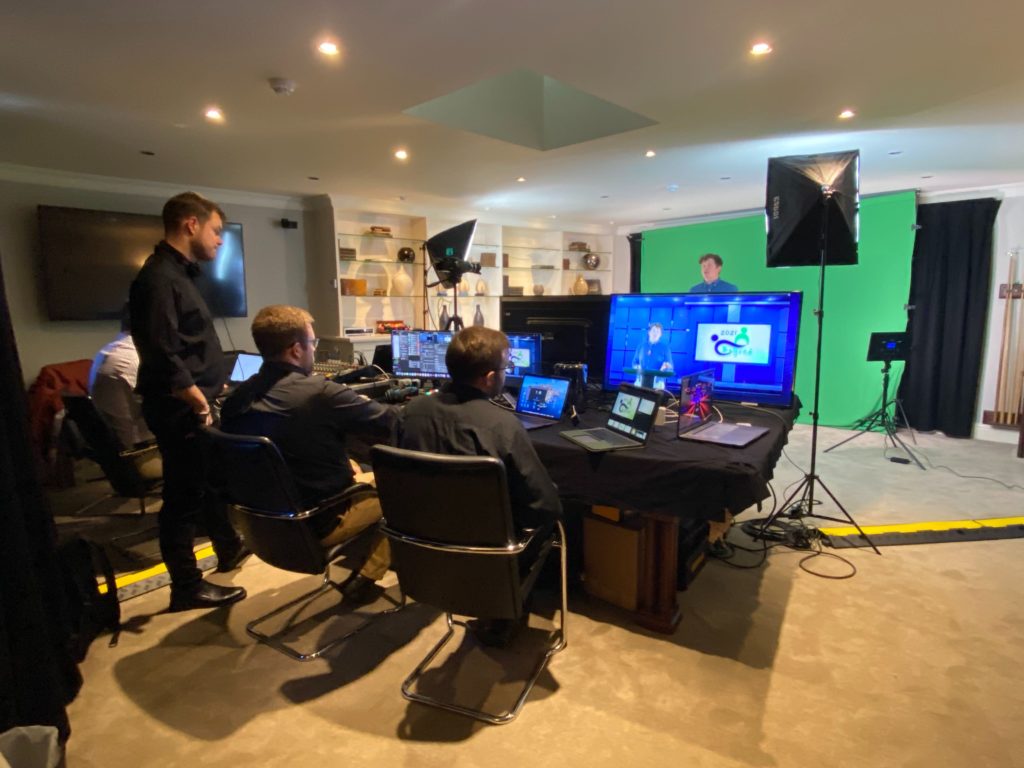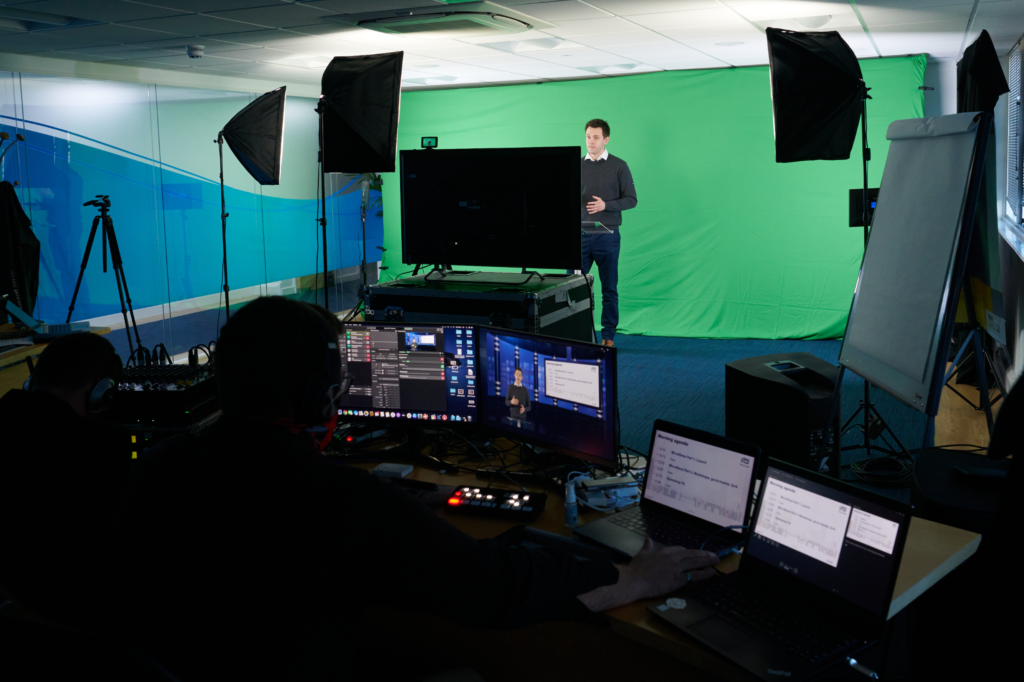Are you researching how to run a virtual conference and wondering where to start? We asked our expert conference organisers for their advice and here’s what they came up with. Successfully running a virtual conference requires great planning: from structuring the online agenda, working with speakers, the technical setup, to creating engagement on the day and beyond.
Onyx Events has earned a reputation for creating and delivering live corporate events that excite, immerse and emotionally engage. In recent years we have seen the rise of virtual conferences and embraced the need to evolve and become a virtual conference production company.
Here, we explore the benefits of going virtual and look at the key steps of how to run a virtual conference to help you plan your own.
So, let’s understand how virtual conferences can benefit your business.

The Benefits Of Running A Virtual Conference
There are plenty of benefits of running a virtual conference. It’s true, it is hard to beat the value of the experiential aspect of ‘live’ events. However, what happens when these are restricted because of things like the coronavirus pandemic? Should companies just cancel their events altogether? The answer for many will be no. But the prospect of organising a virtual event can seem daunting and will the company benefit in the same way?
Here are some of the benefits:
- Global Reach – A virtual conference can be accessed from any device from anywhere in the world.
- Save on the costs of travel and/or accommodation
- Time savings due to reduced travelling
- Removes the headache of organising logistics allowing focus on achieving goals
- Online collateral gives extended lifespan
- Stay connected at a time where in person contact is not possible
- It’s Environmentally friendly conferencing
- It’s easier to collect results and feedback
Virtual conferences and hybrid events are a great way to fulfill company goals and prove as an effective tool for modern business.
Here are our Key Steps of How To Run A Virtual Conference
Successfully running a virtual conference requires planning and preparation. Here are our Key Steps:
- Structuring a virtual event agenda
- Virtual conference Speaker guidelines
- The tech setup
- How to make virtual conference fun and engaging
1. The Virtual Event Agenda
Keeping attendees interested and engaged when they are participating in an online event can rely on the success of a clear virtual event agenda. The agenda sets the scene, allows participants to have some ownership of the event and ultimately help with engagement.
It has never been more important to keep a connection with your employees and corporate communities. Companies still need to function, revenue needs to be generated and strategies on how to do this need to be clearly communicated. Virtual conferences has become a pivotal part of this – but how do you successfully run a virtual conference?
The virtual agenda is the foundation of the event. It helps to set the scene and in the absence of in-person meetings helps to co-ordinate that critical connection needed for success. Extra time should be given to planning the agenda.
To help with that planning process, here’s 5 things to keep in mind when designing an agenda for virtual events.
Highlight Goals and Objectives
Identify the goals and objectives of your virtual conference. In essence, “begin at the end”. Much the same as you would for an in-person event. Clarify exactly what do you want to get out of the event? There may well be differences in goals between internal and external events. For example, if developing relationships is a goal you will need to allow for virtual meet and greets, breakout sessions, ice-breaker activities and virtual networking events. Defining your goals and how you want to deliver them will then dictate the design, features and complexity of your event agenda.
Pre-Event Surveys
This is possibly not something you would have done with a “live” in person event. But for virtual, it can be important to gauge attendee interest in advance. This can help with pre event insights (if further promotions are needed to boost numbers and pre-engagement), highlight ‘weaker’ topics and add value for the attendees. If people are involved at an early stage they should feel more engagement and ownership of the virtual conference.
Decide Session Delivery Mechanisms
The benefit to virtual conferences is that you can vary the session styles. From pre-recorded, to a hybrid mix and 100% live sessions. Variety of session type is good to keep engagement. This may give your event planner more elements to manage and potentially more issues to overcome but there are definitely benefits.
For example, live sessions allow you to interact with speakers, but risk live tech gremlins. On the other hand, pre-recorded elements allow attendees to view sessions at their convenience but can risk lacking engagement. Can you strategically use break outs and Q&A’s to buy you time to queue up the next session elements – this ticks two boxes!

How you decide to deliver your event sessions is directly related to how you configure your virtual event agenda. The thing we love about virtual events is that there is no real wrong answer. Like us, you’ll learn the successful mechanics and tactics. Planning and advance preparation will contribute to a successful, smooth running event. But don’t forget, at the moment, most people are just as new to this as you are.
Carefully Considered Session Timings
It’s important to give consideration to the amount of time your attendees are sitting in front of their computers. Will shorter, sharp sessions be better for engaging your participants? Can you vary the pace of the event by varying the session lengths? Don’t run the risk of session monotony.
Indeed, seeing as there are unlikely to be travel and accommodation costs, can your virtual conference be run over more days but with less required attendance time per day? No-one wants to sit in front of a computer for hours listening to speaker after speaker go on and on.
Importantly, you may need to consider that your teams are located in different time zones. You may need to think carefully about starting and finishing times. As it is a “virtual” event it’s a good idea to make sure the key content is available online for people to view and digest in their own time too.
Breaks to Boost Energy and Engagement
Schedule regular break time between sessions. “Free” or unstructured time will allow people to stretch their legs, get a coffee or hop online and catch up with emails.
Alongside unstructured breaks you can also schedule ‘activities’ such as mindfulness exercises or yoga breaks. Non-work activities can refresh and revitalise attendees. Be proactive and help them unwind between sessions. Employee wellbeing is proven to have significant engagement and creativity benefits. These types of breaks also help to focus them when your key event elements are on the screen.
So, encourage attendees to take breaks. Make it clear that downtime is encouraged by highlighting these within the virtual event agenda.
Your event
Expect the Extraordinary.
Get Inspired. Get Creative. Get Connected.
Build Your Event Today.
2. Virtual Conference Speaker Guidelines
In the same way as you would for a live event, making sure your speakers are well prepared and comfortable is critical for success. When writing your event agenda, do not forget that speakers and presenters need time to prepare between sessions as well. Allow for logging in, testing their tech (hopefully not for the first time though!) and preparing slides or media.
Here’s some top tips:
- Send each speaker an email briefing – introduce the event manager, confirm the agenda and their time slots and what resources they’ll need.
- Can it be pre recorded? If a speaker had never presented on camera, the team asked them to record it in advance.
- Rehearse – individually and where possible hold a full rehearsal session with all speakers
- Test your tech ahead of the event/session (especially if they aren’t in a live studio environment)
- Lighting is key! Project your speakers in the best light, literally…
- Adapt their presentations to virtual – visual cues and gestures that work in a live setting may not work on screen
- Positioning. Create Symmetry with other speakers – especially when there is more than one person on the screen
- Backgrounds – keep backgrounds simple and preferably light – unless you can use a green screen to assist with presentation elements.
- Don’t forget – Eye contact, especially virtually, is what connects you to your audience.
Good content is the backbone of every virtual conference. Having a high quality of presentations should be the key area of focus for a virtual event organiser.

Remember; speakers are subject matter experts, but they might not be experts in presenting on camera. Be prepared to help them, give them a clear agenda and detailed instructions.
3. The Tech Setup
Whether you are able to have a physical hub for your event or are keeping it purely virtual, the technology you use can be a significant contributing factor to its success.
If you’re researching how to run a virtual conference, naturally you’ll want to explore lots of innovative tech. But bear in mind, whilst it’s important to mix up the sessions, it is also key to keep it as simple as possible – especially for your first event!

If you’re going 100% virtual, do your research and find the technology that ideally keeps all your event elements on one resource/platform. This should make it easier to manage and means less to go wrong! Make sure all your presenters and key personnel are familiar with the tech that you choose and have plenty of time for trial runs and testing.
That said, you can also choose to have a “physical hub” or studio to stream key elements of the event from. In this instance, you’ll be able to pre-record your presentation material, or have experts like Onyx events, produce the live event itself – whilst adhering to social distancing of course.
In our case, Onyx have created a dedicated production studio at Chewton Glen Hotel & Spa, in the New Forest. This, combined with our bespoke and fully-integrated event platform delivers a true event experience to your remote attendees. Having software like this enables us to professionally produce virtual events featuring live streaming, content-on-demand, breakout rooms, live polling, real-time networking, gamification, social media integration and activity feeds. It’s a game changer…

Interested in a demo? Get in touch and we’ll give you a virtual show round of the platform.
How to Make A Virtual Conference Fun And Engaging
Once you’ve taken care of the technicalities it’s important to look at how to make your online event engaging. Virtual events can easily lose one of the best benefits of live events: human connection. To mitigate that, keep the content flowing, vary the pace and duration of sessions and get the audience involved.

Here’s a few ideas to make your virtual conference fun and engaging:
- Live polling
- Chat forums
- Q&A – with the ability to ‘rank’ questions people pose in real time so the most popular questions are answered
- Gamification
- Integrate social media – for questions, contests and commentary
- Have breakout “rooms”
- Online Yoga sessions & Mindfulness timeouts
- Online Entertainers – such as sketch artists, magicians
- Virtual Event bags – sent to all delegates with activities inside
By improving your virtual event audience engagement, you’ll take your virtual events to the next level.
Virtual Conference Best Practices
Switching your event online also requires switching your mindset from what you’re used to with live events. Making this transition is also a great opportunity to explore new ways of delivering even better events.
- Think outside of the box. Get creative. Do things you haven’t tried before. E.g., to boost networking, send everyone a packed lunch for a certain hour and invite people to join a virtual lunch call.
- Be brave. Don’t be afraid to try new approaches and technologies. BUT test and plan well in advance.
- If in doubt, ask the experts – make sure your event is successful and achieves all your objectives. Call in a virtual conference production company like Onyx Events.

The Virtual Conference Production Company
We hope this gives you a better understanding of how to run a virtual conference. If you are looking to run an event for your company you may still prefer to call in a virtual conference production company. Get in touch with the expert event planners at Onyx Events and start building your event today.
Onyx has earned a reputation for creating and delivering live corporate events that excite, immerse and emotionally engage. Throughout the COVID crisis we have helped many companies with virtual conferences, sales kick offs and events.
Your event
Expect the Extraordinary.
Get Inspired. Get Creative. Get Connected.
Build Your Event Today.

